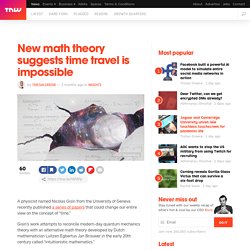

Everything you need to know about quantum physics (almost) What is quantum physics?

Quantum physics is a branch of physics also known as quantum mechanics or quantum theory. Mechanics is that part of physics concerned with stuff that moves, from cannonballs to tennis balls, cars, rockets, and planets. Quantum mechanics is that part of physics which describes the motions of objects at molecular, atomic, and sub-atomic levels, such as photons and electrons. Although quantum mechanics is an extraordinarily successful scientific theory, on which much of our modern, tech-obsessed lifestyles depend, it is also completely mad. Read more about quantum physics: The theory quite obviously works, but it appears to leave us chasing ghosts and phantoms, particles that are waves and waves that are particles, cats that are at once both alive and dead, lots of seemingly spooky goings-on, and a desperate desire to lie down quietly in a darkened room.
The history of quantum mechanics We now know that all matter is composed of atoms. Is light a wave or a particle? The mathematician who helped to reshape physics. In recent years, physics has been swept by ideas from a branch of mathematics called topology.

Topology is the study of objects that deform continuously without tearing, for example through stretching or twisting. But it is now proving crucial to understanding the shapes of quantum waves formed by the electrons inside matter. These waves can form shapes such as vortices, knots and braids that give materials a variety of exotic properties. In 1983, Barry Simon was the first person to make the link between strange phenomena in materials and topology. Simon’s work explained the quantum Hall effect, first described by German physicist Klaus von Klitzing 40 years ago this month1. Von Klitzing won a Nobel prize for the effect’s discovery in 1985. Researchers have since brought ever-more-sophisticated ideas from topology into studies of matter and used them to predict a plethora of physical phenomena.
What made you think there was a connection between the quantum Hall effect and topology? Our changing picture of gravity. When commander David Scott performed the last Moon walk of the Apollo 15 mission he took with him two objects you wouldn’t normally think to bring into space: in one hand he held a feather and in the other a hammer.

When he let the two objects drop they fell towards the surface of the Moon — and landed at exactly the same time. With this experiment Scott confirmed a rather counter-intuitive prediction Galileo Galilei had made nearly 400 years earlier: that gravity causes all objects to fall to the ground with the same acceleration, no matter how heavy they are. The reason we don’t usually see this effect on Earth is that air resistance interferes with the objects' fall. The Moon's atmosphere is much thinner than the Earth's, which is why Scott was able to demonstrate Galileo’s prediction. Newton's theory of gravity. (3) Mathematics and Physics. The Rebel Physicist Trying to Fix Quantum Mechanics.
Weinberg, who wrote a book titled “Dreams of a Final Theory,” mused by phone with me about the possibility that quantum mechanics really is the truth, such that the ultimate theory that physicists dream of would only address human experience and say nothing about nature beyond that.

“That would, to me, be horrible,” he said. “In fact, I might almost conclude that if that’s what it is, the hell with it.” Still, largely because quantum mechanics has passed so many extraordinarily precise tests, collapse models are generally dismissed when considered at all, and few physicists think Bassi will succeed. Even Weinberg, on the phone, characterized his quest as “interesting” but “to some extent whistling in the dark.”
The day after his lecture in Trieste, Bassi was driving me in his blue, weather-beaten Peugeot to his hometown, Colloredo di Prato. New math theory suggests time travel is impossible. A physicist named Nicolas Gisin from the University of Geneva recently published a series of papers that could change our entire view on the concept of “time.”

Gisin’s work attempts to reconcile modern-day quantum mechanics theory with an alternative math theory developed by Dutch mathematician Luitzen Egbertus Jan Brouwer in the early 20th century called “intuitionistic mathematics.” That may sound like the math version of “holistic medicine” but Brouwer’s theory has persisted for more than a century and Gisin’s ideas may just propel it back into the spotlight. The theory itself is complex, but it’s biggest drawing point is that it removes the mathematical need for something called the “excluded middle.” The excluded middle, in math, represents the idea that if a statement is made then either it or its negating statement is true – “I have five apples” or “I don’t have five apples,” for example.
In this scenario, ‘now’ only exists because we’re here to watch it – all time is relative. Mathematical languages shape our understanding of time in physics. 1.Weyl, H.

The Continuum (Dover, 1994).2.Gödel, K. Collected Works Vol. IV (eds Feferman, S. et al.) p. 269 (Oxford Univ. Press, 1995).3.Dolev, Y. Eur.